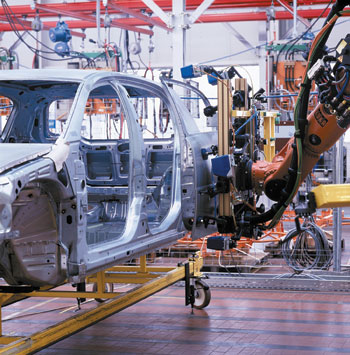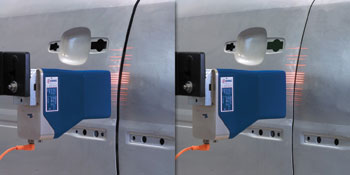Optimized gap dimensions in automobile construction are being used to entice
discriminating buyers.
Horst Mattfeldt, Allied Vision Technologies GmbH
Today’s automobile manufacturing plants bear little resemblance to those in use less than a generation ago. Assembly robots now adapt the position of car body parts to each other before fitting, taking into account geometry variations of each piece for the best-quality result possible.
Best-Fit technology, developed by EDAG GmbH of Fulda, Germany — in conjunction with the Marlin digital cameras manufactured by Allied Vision Technologies GmbH of Stadtroda, also in Germany — is being used for the precise fit of body parts with the smallest and most uniform gaps possible.
Some car manufacturers are highlighting the technique to lure consumers looking for quality in their next purchase. This assembly is now being performed at three European locations, where components that are part of the process include the attached components of the Mercedes Benz S-Class and the doors of the Opel Corsa from GM Europe. In addition, the system is used for applications such as the precise positioning of robot tools that are used for punching, stamping or riveting during automobile production.
In automobile construction, components are assembled predominantly using conventional methods with gauges, which require that the attached components be constantly in a rigid position for installation. This means that sometimes substantial amounts of extra work — in the form of manual adjustment — must be performed. Uniform distribution of gap dimensions — as required today both by designers and quality engineers — is hardly possible using these conventional methods, except through correspondingly high levels of expensive labor.
Best-Fit is a sensor-based assembly process that makes tailored and precise assembly of attached parts possible in automotive production, despite unavoidable geometric variations that arise because of production tolerances. Depending on the design of the attached part, anywhere from six to 11 sensors — such as the EDAG VarioGauge V4 type — are installed on the robot’s gripper.
In addition to electronic control and monitoring systems, this intelligent sensor consists of an adjustable five-line laser source and a digital camera. With the aid of these sensors, the automobile components — for example a door and sidewall — are measured from each other with an accuracy of 0.04 mm.
The Best-Fit system determines the dimensions of the gap and the transition for each manufactured door along with the cutout in the sidewall of each corresponding vehicle — and calculates the optimal position for installation of that specific door with respect to the car body.

The Best-Fit system adapts assembly to the geometric variations of individual parts.
For measurement, the door is held by the robot in the preset assembly position. The EDAG VarioGauges project a laser line pattern on the gap between the door and the car body at several strategic points. For each sensor, the projected image is captured by a digital camera that is integrated into the gauge, and the image is transmitted to the VarioInspector vision system installed on a PC.
The analysis of the shape of the projected lines gives a precise measurement of the width of the gap between the two surfaces and determines whether they are flush. The sophisticated angled projection produces a parallel offset of the laser lines on the background part (car body), making it possible to calculate the distance between the two parts in the third dimension (depth) and to optimize flushness.
Comparing the required values with the measured data for each of the control points, the system uses an algorithm to calculate the best possible fit, providing optimal results at all points. Once each position is calculated, the system drives the robot to target this position precisely. The software ensures not only the most parallel possible gap dimensions but also uniform distribution of the gap dimensions at all measurement positions. It also is possible to set priorities among the measuring points and to define fitting strategies — for example, to minimize gap width where consumers see it most or to optimize gap parallelism between two points.

To improve construction quality, some car manufacturers are using a laser source and digital camera to ensure precise gap measurements.
For better integration into the EDAG VarioGauge sensor, the housing of the standard camera was removed, and the board-level version was selected. With a resolution of 1.4 megapixels, the cameras permit precise gap measurements. In addition, the cameras are equipped with a FireWire digital interface that can be used to activate all the cameras of the Best-Fit system via a broadcast trigger. Internal memory and the deferred mode of these cameras provide flexibility, allowing images from each camera to be called up for analysis.
According to Christian Böttcher, technical manager for image processing technology, the deferred mode of the cameras is the best match for the Best-Fit application.
“The industrial suitability of the FireWire interface was important to us in selecting a camera,” he said. “We were able to design a special hub with fiber optic data transmission from the assembly gripper to the Best-Fit computer, which makes the image-processing technology immune to electrical and magnetic interferences within the system.”
The Best-Fit process is a milestone for assembly quality in automotive production. For each manufactured component and body, the system calculates the optimal position for assembly, providing the vehicle with a uniform and high-quality appearance. In addition to the quality advantage of perfect distribution of the gap dimensions, the system achieves economic advantages: The costs of manual readjustment are reduced drastically, as the implemented projects have shown clearly.
Meet the author
Horst Mattfeldt is technical director at Allied Vision Technologies in Stadtroda, Germany; e-mail: [email protected].